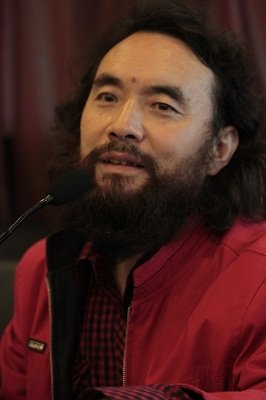
“Mahamudra: Essence and Practice ”( Book II)
The Essence of Mahamudra
◎Yixin Chen: Is Mahamudra confined to Buddhism?
●Xuemo:Mahamudra originated from Buddhism, yet it has surpassed the confines of Buddhism. I have a new definition of Mahamudra, which has won approval from many. In light of mind, vision, heart, and aspiration, “maha-” means great, while “-mudra” literally means “hand seal.” As “hand” represents engagement, it implies one must embody great heart, great aspiration, great mind, and great vision in actions. “Seal” refers to the primordial wisdom, which is luminous, empty in nature, and it is at once spontaneous empathy and ultimate transcendence. Mahamudra is not merely religious wisdom; rather, it can manifest itself as a certain vision of life, a certain attitude to life, a certain mode of behavior, a certain principal of engagement, a certain bearing in life, and a certain quest for spirituality. Mahamudra is the wisdom inherent in humanity. As the Chan school of Buddhism puts it, within each person lies an innate luminous pearl that is enwrapped in worldly impurities; as one wipes clean the impurities, needless to say, its radiance gleams. Such a process of purification is known as austerity practice.
As a matter of fact, the essence of Buddhism is harmony, which allows connection between one’s body and mind and establishes one’s close rapport with society and the world. But nowadays, there is a certain prejudice against religion that is grounded in misunderstanding. Some perceive negativity in Buddhism, thinking that they need to dodge the world and stay away from the crowd. In fact, such a view is due to the acceptance of some inferior, vulgarized interpretations of Buddhist doctrines as the entirety of Buddhism. For example, many think that the aim of Buddhist practices is to seek divine blessings for personal material gains, which is indeed awfully self-serving. Believers like these come in large numbers; they conduct themselves in a businesslike manner, hoping to receive huge benefit on a tiny offering. Consequently, such a mind-set engenders misunderstanding about Buddhism.
The very essence of Buddhism is the wisdom of transcendence, such as the philosophies of Mahamudra and the Chan school. The achievers of Buddhist practice have already surpassed the self-serving mind-set, so much so that things of the mundane world have little value to them, but just like the tip of the pyramid, there are very few of them. Nevertheless, the transcending and non-self-serving wisdom is not necessarily recognized by the world because, after all, what the majority of people need is material gains.
What’s so pathetic about human beings is that they need a savior, a divine being that offers blessings, a personified God who can bestow on them well-being, good fortune, job promotion, and abundant wealth. On the contrary, being non-theistic, Buddhism aims at smashing such concepts. For Ch’an practitioners, as they reach the advanced meditative state, they will sweep away all rising illusions, including that of buddhas as well as that of evil demons. When impurities like brutality, greed, enmity, ignorance and all sorts of cravings are removed, one’s nature becomes identical to that of buddhas and bodhisattvas. Such a philosophy was expressed by Laozi in his Tao Te Ching. Laozi said, “Seeking knowledge increases samsaric cravings, seeking awakening decreases samsaric cravings, decreases down to the state of inertia, where the state of inertia accomplishes all.” Buddhist cultivation is precisely a process of clearing away spiritual filth, rubbish, habitual patterns, and cravings. In the situation where people’s view of religion is affected, it is the result of certain cults’ embezzlement of Buddhist and other religions’ terminology. In fact, there are two aspects of religion: the first is self-examination and the second is yearning, yearning for an existence that is greater than humanity. The way of self-examination might not be the same among religions; nevertheless, the significance is similar, such as the practice of confession in Christianity. However, due to misconception, people always feel that religious introspection is odd.
As a matter of fact, religion is much needed in this age. Instead of shackling ourselves with dregs of religion, we nourish our spirit by assimilating the essence of religion. This way, religion becomes exceptionally meaningful.
This is me; to this day I am neither a follower nor a believer of any religion. I always say: don’t relegate me to an insignificant sect, or to the great Buddhism, or to lots and lots of religions. This is not the case; I am not a follower of a religion. I am merely a truth upholder; there is neither sectarian nor national limitation. All of humanity’s outstanding phenomena are my nourishment and they will not be turned into shackles or ropes to bundle up my spirit. In order to allow myself to be as “vast” as can be, I have encompassed everything as my nourishment. To be truly free and liberated, shackles, limitations, and spirit constraining factors must all be smashed.
Therefore, Mahamudra is precisely what allows us to live under the guidance of a particular insight. As one reaches a certain state of awakening, we may then call it the penetration of Mahamudra. For example, in the case of the Buddha holding up a flower and Kasyapa smiling, it represents the Buddha’s particular state of awakening, which can be experienced by another person, and then that person is considered to be corresponding to the Buddha’s mind. This is known as mind-to-mind transmission or mind-to-mind seal.
Notice
Translated by non-professional volunteers, there would be some inaccuracies in the translation. You are welcome to offer us some advice for emendation. Please feel free to contact us.We also look forward to you joining our voluntary translation team.
Please contact us at suonanzhuoma1988@163.com, thank you.
《光明大手印:实修心髓》 下
大手印的本质
◎陈亦新:大手印只属于佛教吗?
●雪漠:大手印源于佛教,但超越了佛教。我对大手印有新的诠释,得到了许多人的认可。“大”,就是大胸怀、大境界、大心、大愿;“手”代表行为,你必须把大心、大愿、大胸怀、大境界体现在行为上;“印”,是明空智慧,是超越,它既是当下关怀,又是终极超越。大手印不仅仅是宗教智慧,更是一种人生境界、一种人生态度、一种行为方式、一种处世理念、一种人生坐标、一种精神追求。大手印是人类本有的、本来俱足的智慧,正如禅宗里面说的,每个人的心中都有明珠一颗,只是被世俗的污泥裹住了,当人把污泥擦掉,光明自然会绽放。那种去污的过程就是修炼。
事实上,佛教的本质是和谐,让自己的身心和谐,让自己和社会、和世界和谐。但现在社会上对宗教有一种偏见,这种偏见源于误解。有人认为佛教是消极的,要躲避这个世界、远离人群,其实不是这样的。因为,有一些人把佛教中非常低层次的、通俗化的解释当成了佛教的全部,比如好多人认为佛教就是求菩萨保佑自己升官发财等等,很功利。这些信徒人数众多,他们像做生意那样,想靠供一点东西而得到巨大的利益。所以,人们对佛教产生了误解。
佛教真正的精髓是超越的智慧,比如大手印、禅宗的思想。佛教的证悟者是超越功利的,他们甚至不会在乎这个世界,但这部分人数量很少,就像金字塔的那个顶端。然而,对这些超越性的、没有功利性的智慧,世界却不一定认可它,因为许多人需要功利。
人类非常可悲的地方,就是需要一个救世主,需要一个保佑他们的菩萨,需要一个能给他们带来平安、幸福、升官、发财的人格化的上帝,而佛教是要打碎这些的,佛教是无神论。修禅之人达到很高境界时,就会佛来也杀,魔来也杀,他认为这些都应该扫掉。当他消除了兽性,消除了贪婪、仇恨、愚昧,扫除了所有的欲望的时候,他和佛陀和菩萨就是一体的。这个道理在老子的《道德经》里也有,老子说:“为学日增,为道日损,损之又损,以至于无为,无为而无不为。”修道就是扫除心灵的污垢、垃圾、习气、欲望的过程。一些邪教正是盗用了佛教和其他宗教的名相,才影响了人们对宗教的看法。事实上,宗教包括两个方面,第一个是自省,第二就是向往,向往比人类更伟大的存在。宗教里的自省方式可能不都一样,但意义是相同的,比如忏悔,基督教里也有。但人们总觉得宗教里的自省很奇怪,这是因为误解的原因。
事实上,这个时代,非常需要宗教。如果我们能从宗教中汲取真正的营养来滋养自己的心灵,而不是将宗教中糟粕的东西变成枷锁,来捆绑自己的时候,宗教是非常有意义的。
我就是这样,直到今天,我既不是教徒,也不是信徒。我常说,不要把我归入一个小小的教派,或者大大的佛教,或是多多的宗教。不是这样的,我不是教徒。我只是一个信仰者,在我的眼中没有什么教派局限,没有什么民族局限,所有人类非常优秀的东西都是我的营养。它不会成为枷锁,不会变成绳子把我的心灵捆住。我把所有的东西都当成了我的营养,让我尽量地“大”起来。要打碎所有的桎梏、所有的局限、所有的控制心灵的因素,这才是自由,这才是解脱。
因此,大手印就是让我们在某种见地的指导下去生活,当人达到某一种境界的时候,我们就可以称之为契入大手印。比如,佛陀拈花微笑的时候,他代表了某一种心灵的境界,这种心灵的境界让另外一个人感受到了,然后他与佛陀的心就相应了,这叫以心传心、以心印心。
声明:本文系文化志愿者试译,非专业人才翻译,错误定然不少,如出现疏漏及错误,敬请读者见谅。如有任何翻译上的建议及修正意见,欢迎及时与我们取得联系,我们会加以校对、修改,并希望有专业才能的朋友也能加入我们志愿者群体中来。
邮箱地址:suonanzhuoma1988@163.com


